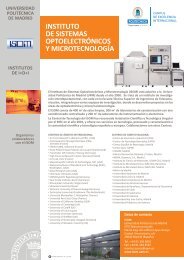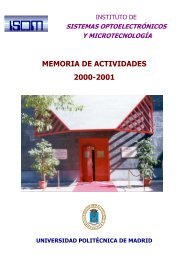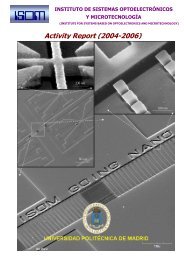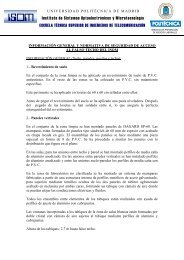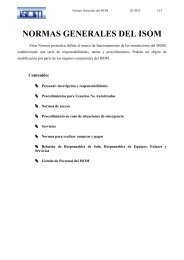Graphene-on-SiC - ISOM
Graphene-on-SiC - ISOM
Graphene-on-SiC - ISOM
Create successful ePaper yourself
Turn your PDF publications into a flip-book with our unique Google optimized e-Paper software.
NEWS ANALYSIS<br />
Lower cost LED lighting<br />
Will Cree’s $10 LED light bulb end America’s<br />
century-l<strong>on</strong>g incandescent love affair asks<br />
Compound Semic<strong>on</strong>ductor.<br />
as inDUstrY antiCiPatEs an lED<br />
market upturn, Cree has just unveiled a<br />
new line of lower-priced, incandescent<br />
look-alike bulbs that could speed the<br />
recovery. Costing from $10, coming<br />
with a ten year guarantee and offering<br />
a similar light output to the much-loved<br />
incandescent − but rated to 25,000,<br />
not 1000 hours − the bulbs have been<br />
developed specifically to kick-start<br />
sluggish domestic lighting markets<br />
across the Us.<br />
as Cree’s vice president of corporate<br />
marketing, mike Wats<strong>on</strong>, told Compound<br />
Semic<strong>on</strong>ductor: “We didn’t think this<br />
segment was moving fast enough so<br />
we’re giving c<strong>on</strong>sumers a reas<strong>on</strong> to<br />
switch to lED lighting. they love the<br />
shape and the light that comes out of the<br />
incandescent so we’ve given them a bulb<br />
that they are used to, at a price point they<br />
will try.”<br />
and the feedback is good. Described in<br />
the MIT Technology Review as “the lED<br />
bulb Edis<strong>on</strong> would love” and reported<br />
by many to “look like and light like” an<br />
incandescent, this is a bulb that the<br />
likes of Philips lighting and GE will find<br />
difficult to ignore. the new line of lED<br />
bulbs includes three models; a warm<br />
white 60 W-equivalent 9.5 W bulb priced<br />
at $ 12.97, a daylight 60 W-equivalent,<br />
9 W bulb at $ 13.97, and a warm white<br />
40 W-equivalent, 6 W bulb at $ 9.97.<br />
Each has a colour rendering index of at<br />
least 80 with both warm white versi<strong>on</strong>s<br />
emitting a 2700K pleasant warm light and<br />
the daylight bulb a cooler-looking 5000K<br />
light.<br />
meanwhile, the Philips lighting 60<br />
W-equivalent incandescent copy cat,<br />
delivers a cooler 3000K at 10 W for<br />
$14.97, while the GE lighting equivalent<br />
rings in at around $ 45. all bulbs promise<br />
a lifetime of around 25,000 hours, a<br />
l<strong>on</strong>g-term guarantee, but <strong>on</strong>ly the Cree<br />
bulb hits that magic $10 figure. so how<br />
does the lED heavyweight do it? a 40 W<br />
bulb comprises ten of Cree’s phosphorc<strong>on</strong>verted<br />
high voltage Xlamp Xt-E lEDs<br />
with the 60 W versi<strong>on</strong> c<strong>on</strong>taining twenty<br />
of the same. Phosphor is applied directly<br />
in the lED package to produce white<br />
light. Pairs of lEDs are mounted around<br />
the lamp’s heatsink with Cree calling<br />
the entire vertical structure the Filament<br />
tower.<br />
“the lEDs are arranged in a parallel<br />
c<strong>on</strong>figurati<strong>on</strong> to get as close as possible<br />
to the line voltage of the power supply,”<br />
says Wats<strong>on</strong>. “We can reduce the<br />
comp<strong>on</strong>ent count <strong>on</strong> the driver, making<br />
it simpler and lighter, and we need less<br />
metal, helping us to replicate the look of<br />
an incandescent bulb.”<br />
indeed, Wats<strong>on</strong> is keen to emphasise<br />
the simplicity of its latest bulb. “We’ve<br />
designed this 100 percent, and sourced<br />
the necessary comp<strong>on</strong>ents,” he says.<br />
“take it apart and you’ll see how<br />
simple and elegant it really is. We<br />
needed something that could fit into<br />
this form factor and give you the look<br />
of incandescent light, at a low enough<br />
cost.”<br />
Wats<strong>on</strong> asserts ‘entire system’<br />
breakthroughs − from the lED and power<br />
supply to optics and design − have<br />
been crucial to cutting costs but also<br />
attributes the $10 figure to the company’s<br />
structure. “We’re vertically integrated and<br />
can adjust many variables at the same<br />
time and better than if we were using the<br />
traditi<strong>on</strong>al supply chain,” he says. Vertical<br />
integrati<strong>on</strong> or not, many industry sources<br />
believe Cree is <strong>on</strong>to something. Pars<br />
mukish, analyst at Yole Développement,<br />
believes the bulb will serve its purpose<br />
and trigger greater c<strong>on</strong>sumer adopti<strong>on</strong> in<br />
the Us domestic lighting market.<br />
“today’s main issue with lED lighting<br />
for residential applicati<strong>on</strong>s is the upfr<strong>on</strong>t<br />
cost,” he says. “the incandescent<br />
costs less than a dollar, the compact<br />
fluorescent lamp costs between $3 and<br />
$5 while the lED lamp, before this, was<br />
between $15 and $40, depending <strong>on</strong><br />
geography and rebates offered.“<br />
But of course the Cree bulb changes this.<br />
and as mukish adds: “ in the previous<br />
era of lEDs, it was all about increasing<br />
Cree’s ‘Filament<br />
Tower’ mimics<br />
the filament of<br />
an incandescent<br />
light bulb<br />
the lumen per watt. now it is all about<br />
increasing the lumen per dollar... we<br />
think [Cree has] a good strategy as the<br />
potential volume triggered by residential<br />
lighting will be a virtuous circle for the<br />
company to c<strong>on</strong>tinue decreasing costs.”<br />
indeed, questi<strong>on</strong> Wats<strong>on</strong> whether<br />
the bulb could match the efficiency<br />
and quality of past winners of the<br />
Us Department of Energy’s l Prize<br />
competiti<strong>on</strong> and he bluntly says: “the<br />
l prize is fun, and industry rewards are<br />
fun, but the prize that Cree wants is<br />
c<strong>on</strong>sumer adopti<strong>on</strong>.”<br />
“the bulb is designed to meet Energy<br />
star requirements but has also been<br />
designed to be affordable with or without<br />
that. it can pay for itself in about a year...<br />
so without any rebate or government<br />
regulati<strong>on</strong> we have made the maths<br />
work,” he adds. “anything else we do<br />
<strong>on</strong> that [the efficiency] side will now just<br />
make this even sweeter.”<br />
so while the bulb is currently available<br />
in home Depot stores across the Us,<br />
what about the rest of the world? it<br />
will have to wait. Wats<strong>on</strong> believes the<br />
greatest demand currently lies in the Us,<br />
adding:“Europe uses a lot of recessed<br />
track lighting whereas the Us market<br />
already has a very large installed base of<br />
a lamps.”<br />
still Cree’s Us focus looks to be working;<br />
the release of the products saw Cree’s<br />
shares rise 13 percent to the highest level<br />
in two years. We have yet to see if Us<br />
c<strong>on</strong>sumers will snap up a $10 lED lamp,<br />
but at the very least, Cree has brought<br />
affordable lED lighting closer to home.<br />
© 2013 angel Business Communicati<strong>on</strong>s.<br />
Permissi<strong>on</strong> required.<br />
20 www.compoundsemic<strong>on</strong>ductor.net April/May 2013






